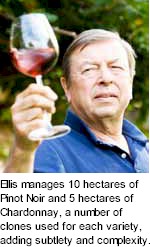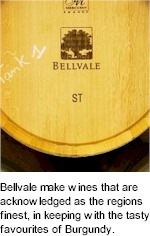


Situated along the lush Tarwin River valley of South Gippsland, the area is acknowledged as one of Australia's best Pinot-Noir producing regions. This is reflected in Bellvale's numerous international and national awards over the last decade. The name, Bellvale, is derived from the Ellis family's rich agricultural heritage, which may be traced back to a farm in Nieuw Amsterdam (the New York area), in the late 1600s. The Bellvale label features two majestic oak trees that grace the centre of its vineyard. Exposure to Australian wines sparked an interest in terroir down under. What followed was a lengthy period of research and the selection of South Gippsland's cool climate. John now produces wines that are acknowledged as some of the regions finest, in keeping with the premium producers of the Burgundy region.

John Ellis spent many years on Long Island, in southeast New York, before emigrating to Australia in the 1980s. His abiding passion for fine wine and viticulture stem from extensive free time spent in Europe during a 25 year career as a commercial pilot. To maintain his interest, John followed several agricultural paths during that time, including planting Cabernet Sauvignon and Merlot to supply the first vineyard in the Hamptons during the 1970s. Over time came many trips to Burgundy to hone his knowledge of traditional French winemaking methods and traditional viticulture.
Ellis chooses to adhere to the traditional methods of the premium producers in the Burgundy region, where vine density is high and crop load limited to sacrifice quantity for quality. He manages 10 hectares of Pinot Noir and 5 hectares of Chardonnay, a number of clones used for each variety, adding subtlety and complexity.
Bellvale's flavour profiles present the full expression of a vineyard tended the artisan way. Ellis ensures that the vineyard creates the wine, there are no fancy tricks in the winery. The only embellishments are maturation in a combination of new and used French oak barriques for a minimum of 12 months.

Not so long ago, the South Gippsland region along Australia's southeast coast represented brave new territory for Pinot Noir grape growers. It is now acknowledged as one of the country's leading Pinot Noir-producing regions, with Bellvale's own vineyard rated as one of the top two for the region. There are a combination of warm days and cool evenings because of the southwesterly flow off the Southern Ocean, which is beneficial to the ripening process. Irrigation is unnecessary and the vineyard enjoys excellent drainage, a propitious north facing hillside position, large natural terraces, basaltic red clay loam soil of ancient volcanic. These are all conditions which yield exemplary harvests for the crafting of outstanding Victorian wines.
Bellvale's Pinot Noir is elegant and well structured, featuring a powerful palate of rich, ripe black fruits, with a fine oak influence. Her cool climate Chardonnay is crisper, due to higher acidity, tightly structured, with a well defined balance between fruit, secondary characters and integrated oak. The estate's vines have extensive and very deep root systems, which allow the fruit to more effectively express the terroir. John Ellis concurs with the French masters that great wine is made in the vineyard. The knowledge and experience Ellis gained working vintages in Burgundy translate into Australian wines of amazing richness, seamless integration and the most wonderful complexity.
